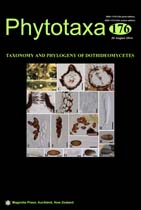Abstract
A collection of the type species of Phaeosphaeriopsis, P. glaucopunctata, and a new species associated with leaf spots of Ruscus aculeatus were collected in Italy. Single ascospore isolates of both species were obtained and formed asexual morphs in culture. Combined ITS, LSU, SSU and RPB2 gene sequence analysis from taxa in Phaeosphaeriaceae showed that P. glaucopunctata and the new species cluster in Phaeosphaeriaceae, forming a separate clade from other species in the family. In this study, we designate our new collection of P. glaucopunctata as an epitype. The new Phaeosphaeriopsis species is morphologically similar to P. glaucopunctata , but has 3-septate ascospores. A detailed description and illustration is provided for both species and the new taxon is compared with other Phaeosphaeriopsis species. Phaeosphaeriopsis musae is excluded from Phaeosphaeriopsis based on morphology and multigene phylogenetic analysis and synonymized under Phaeosphaeria musae. In present study seven species are accepted in the genus Phaeosphaeriopsis and a key to species is provided.

